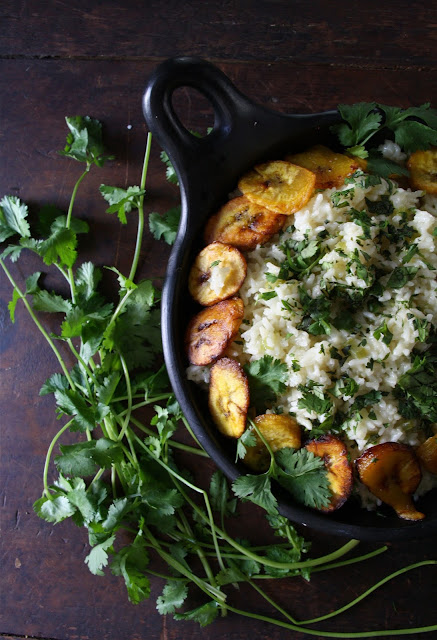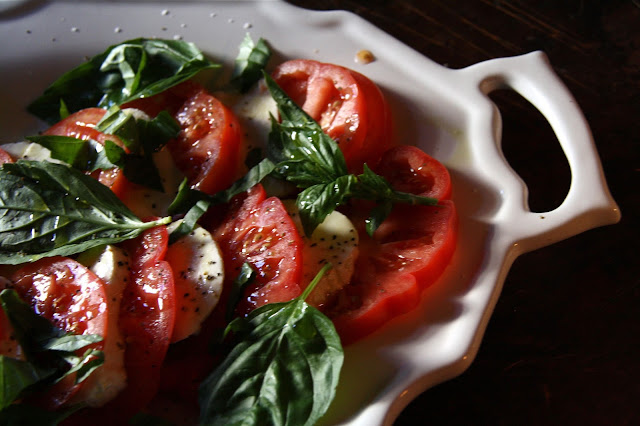Ready, set, it's almost time to get your stretchy pants on! In less than twenty-four hours the Thanksgivings festivities, food fest, annual Turkey Trot races, football binging, and family drama begins! As this is my most favorite holiday, I can hardly contain my excitement for the day. Ours will be a somewhat non-traditional day, one without turkey (be still my traditional heart), one without my niece at the dinner table (unfortunately collegiate swimmers going to school on the east coast don't get to come home for this holiday), one drama free (we didn't invite our individual politics to the table), one beginning with a hometown 5K run with some of my friends, and one where this Roasted Butternut Squash Salad with Warm Cider Vinaigrette will be served for the 'first' time on Thanksgiving.
If your Thanksgiving menu isn't yet carved in stone or if you have been asked to bring a dish to a gathering, consider making this Roasted Butternut Squash Salad with Warm Cider Vinaigrette. And if for some reason, you can't bring yourself to make yet another trip to the grocery store or couldn't possibly add one more 'new' dish to your Thanksgiving holiday meal, then plan to make this salad for your next dinner party while butternut squash is still in season. It took me six years to make this salad (this is what happens when one has too many cookbooks, cooking magazines, recipes clipped from newspapers, or recipes shared by friends). Hopefully it won't take you that long. I have already made it twice and will be making it for a third time for Thanksgiving (my contribution to this year's family dinner at my sister's house).
The benefit of now making this salad a couple of times is figuring out the adjustments to the recipe albeit relatively minor ones. The first time I made it I tossed the arugula, roasted squash, cranberries, roasted walnuts and grated cheese with the dressing. While still delicious, it felt that the salad become a little 'overdressed' and didn't have as much as the visual 'wow' factor on the platter. The second time I tossed the arugula only using about a 1/4 cup of the dressing then arranged the squash, cranberries, walnuts and cheese on top. The remainder of the dressing was served on the side. I liked it even more the second time.
The second adjustment may or may not be an adjustment at all, more like a preference. And it involves the cranberries. More on that later.
Technically butternut squash is a fruit, although we treat it more like a vegetable. It's tan-yellow skin is easily peeled with a vegetable peeler. Normally it is sliced lengthwise (be sure to have a good sharp knife), but for this salad you can (if you want) cut half-inch slices starting at the smaller/top end of the butternut squash. When you get near the bottom of the squash, the place where all of the seeds are, it is much easier to cut in half. Scoop out the seeds and cut into one half inch slices. Keep cutting the slices of squash until you have beautiful deep orange little 1/2 inch diced bites.
The diced butternut squash is tossed with extra-virgin olive oil, pure maple syrup (use the real stuff), kosher salt and pepper and baked for 22-24 minutes in a preheated 400 degree (F) oven. At least once during the baking the process use a spatula to turn over the squash. To test for doneness, insert a sharp knife into several pieces of the squash. If the knife goes through easily, your butternut squash is done.
Okay here's the part where I talk about the cranberries. In the original recipe the cranberries were added to squash during the last 5 minutes of baking. I did this the first time I made this salad. Somehow I forgot to add them the second time and instead simply added them to the salad. Either way worked, but I think I liked them added to salad instead of being baked.
The dressing can be made a day ahead, brought to room temperature and slightly reheated or it can be made while the butternut squash is roasting. The apple cider, cider vinegar and shallots are cooked over medium-high heat until the mixture reduces to about a 1/4 cup. The dijon mustard, kosher salt, pepper, and extra-virgin olive oil are whisked in after you take the pan off the heat.
Walnuts are always better toasted. In a 350 degree (F) oven they toast up beautifully in 8-10 minutes. If you don't have a thin slicing grater to create chards of the Parmigiano-Reggiano cheese, use a vegetable peeler. And if all else falls, use a boxed grater.
Lightly dress your arugula with about a 1/4 cup of the dressing and taste. If it needs more, add more. Season with kosher salt and pepper. Serve the remaining dressing on the side.
Evenly scatter the roasted butternut squash, cranberries (baked or unbaked), toasted walnuts and grated cheese and serve.
The Roasted Butternut Squash Salad w/ Warm Cider Vinaigrette is what I would call a 'platter' versus a 'bowl' salad. Whether you make it for Thanksgiving, for a dinner party, or even a weeknight meal, bring out one of your favorite platters so everyone can first eat with their eyes before they actually taste the sweetness of the butternut squash, the tartness of the dried cranberries, the nuttiness of the cheese and walnuts, and the peppery bitterness of the arugula all dressed in a warm cider vinaigrette. Pure beautiful deliciousness!
Wherever or however you are celebrating the Thanksgiving holiday this year, may your day be filled with joy, harmony, peace, contentment, abundance, and gratefulness. As you take time to be thankful for the family you love, for the friends you cherish, and for all of the blessings received and yet to come, take some time to spread the holiday spirit to others. Happy Thanksgiving wishes to all of you!
Recipe
Roasted Butternut Squash Salad w/ Warm Cider Vinaigrette (slight adaptations to Ina Garten's Roasted Butternut Squash Salad with Warm Cider Vinaigrette as shared in the Barefoot Contessa's Bake to Basics: Fabulous Flavor from Simple Ingredients cookbook)
Ingredients
1 1/2 to 2 pounds butternut squash, peeled and cut into 1/2 inch dice
1/2 cup plus 2 Tablespoons extra virgin olive oil, divided
2 teaspoons kosher salt and 1 teaspoon black pepper, divided
1 Tablespoon pure maple syrup
1/4 cup dried cranberries
3/4 cup fresh apple cider
2 Tablespoons cider vinegar
2 Tablespoons minced shallots
2 teaspoons Dijon mustard (recommend Maille)
4 - 5 ounces baby arugula, washed and dried
1/2 cup walnut halves, toasted
1/4 cup freshly grated Parmigiano-Reggiano
Directions
1. Preheat oven to 400 degrees (F).
2. Place diced butternut squash on a baking sheet. Add 2 Tablespoons extra-virgin olive oil, the maple syrup, 1 teaspoon kosher salt and 1/2 teaspoon black pepper and toss.
3. Roast squash for 22-24 minutes, turning once, until tender. Note: Add cranberries to the pan for the last five minutes of roasting or save cranberries to toss in salad.
4. While squash is roasting, combine apple cider, cider vinegar, and shallots in a small saucepan. Bring to a boil over medium-high heat. Cook for 8-10 minutes, or until cider is reduced to about 1/4 cup. Remove from heat.
5. Whisk in dijon mustard, 1 teaspoon kosher salt and 1/2 teaspoon black pepper. Whisk in 1/2 cup extra-virgin olive oil until dressing is emulsified.
6. Place arugula on a large platter. Spoon about 1/4 cup of the dressing over the arugula and toss.
7. Top with the roasted squash mixture, walnuts, cranberries (if not already combined with the roasted squash) and grated Parmigiano-Reggiano. Sprinkle with salt and pepper. Serve extra dressing on the side.
8. Serve immediately.
Notes: (1) My butternut squash was cut into a 1/2 inch. Original recipe called for cutting into a 1/4 inch dice. If cut smaller, adjust roasting time. (2) Use a good quality fresh apple cider, the kind found in the refrigerator section of a grocery store or orchard. (3) Toss salad in the dressing right before serving. (4) The butternut squash can be peeled, diced, put in a ziplock bag and stored in the refrigerator several hours or the night before roasting.
The edge of Lake Michigan in South Haven before sunrise. (November 2016)
































































